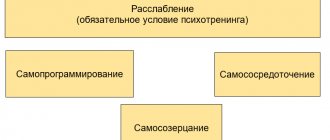Introduction
One of the most interesting properties of the living world is its ability to adapt: organisms flexibly adapt to the external and internal environment in which they exist. This innate ability of every healthy individual of the living world determines the preservation of a given biological species and the survival of its specific representative.
In modern psychology, there are theories suggesting that many properties of the human psyche were formed on the basis of the biological properties of the body. Thus, instincts in the process of socialization of the individual turn into human feelings. For example, anger is a manifestation of aggression, which is based on the instinct of self-preservation; fear is another form of the instinct of self-preservation, originating in the desire to escape from a stronger enemy. The reproductive instinct is transformed into a feeling of love for a person of the opposite sex or a child (parental instinct).
Such a transformation of the biological into the psychological can occur not only in the sphere of instincts. Perhaps the ability to adapt to the physical environment is transformed into the ability to adapt to the psychological one. Then the methods of adaptation become the mechanisms of psychological defense, which will be discussed in this work.
What can you do consciously on your own?
Psychological defense mechanisms are activated at an unconscious level, that is, the person himself can use other methods of resolving conflicts
First of all, it is important to know the peculiarities of information transformation, in fact, why so many conflicts arise (picture below)
Transformation of information during communication
Thus, it is important to manage your emotions well and identify feelings as accurately as possible. But at the same time, you need to learn to express these feelings, that is, develop communication skills and self-control.
I suggest you get acquainted with some ways of self-regulation and optimization of mental state.
Self-massage
Ideal for relieving tension. Walk the backs of your hands over your body from forehead to toes. You will relax your muscles, which will reduce anxiety and stress, and reduce agitation.
Relaxation
Give yourself 15 minutes every day to relax your body and free your thoughts. It is recommended to conduct the lesson in dim light, in a chair, freeing yourself as much as possible from clothing and other accessories (including contact lenses). Tighten alternate muscle groups 2 times for 5 seconds. Perform an action, for example, lift your leg as high as possible, and then release it. Keep your breathing even.
Breathing exercises
Exhale as deeply as possible, slowly inhale all the air in the room, hold for 5 seconds. Now exhale smoothly. Do you feel a change in consciousness and thoughts? Repeat the exercise. After several repetitions, calm down, count to ten, feel how your consciousness becomes more and more clear with each count.
Neurolinguistic programming for anxiety
NLP (neurolinguistic programming) is a popular direction in the psychology of consciousness correction
I offer you a technique that reduces anxiety, which is so important, because it is the harbinger of the activation of defense mechanisms
- Describe your anxiety in detail: its essence, form, content, or even appearance.
- How many times a day (week, month) and for how long do you devote yourself to it?
- Determine a place and time when and where anxiety never visits you.
- At this time, offer your brain a playful game of “let's worry.” Yes, like that, wedge by wedge. Think only negative things, but at this time and in this place. Gradually you will ban your anxiety there.
- Finally, thank your mind: “Thank you, brain, we did a good job. I knew you wouldn't let me down."
As a result of such regular exercises, your resistance to stress will increase and your attitude towards failure will change. You will not experience them as emotionally and difficultly as before.
The NLP technique does not have an unambiguous attitude towards it among specialists and clients; some consider it dubious, others consider it the optimal method of correcting consciousness. I think that the method itself is not bad, but it is not suitable for everyone.
Imaginarium
- Imagine your strongest and most current negative feeling at the moment or what you want to get rid of.
- Imagine yourself as a cartoon (film) character. Don't limit yourself. The only thing you should have in common with him is emotions and feelings, and the rest is up to you.
- Now take a closer look at your surroundings. What and/or who do you see?
- Now imagine a story where your hero’s emotions change for the better. Don't be limited by reality. In the imaginarium, anything is possible.
This exercise reveals your inner reserves, suggests answers, and develops the ability to feel and express your feelings.
Concept and functions of psychological defense
The concept of “psychological defense” was introduced into science in 1894 by the Austrian psychiatrist Sigmund Freud within the framework of the psychoanalytic theory he developed and founded.
In psychoanalysis, a person’s personality was considered as consisting of three substructures: Id (It), Ego (I) and Super-Ego (Super-I):
- The id is a biological substructure, a set of innate instincts and drives, guided by the principle of pleasure.
- Ego is consciousness, a substructure of personality, based on the principle of reality and focused on “reasonable contact with the outside world” [3, p.86].
- Super-Ego is a social substructure that is formed in the process of educating an individual in society (mainly during early childhood) and includes social norms accepted in a given society and internalized by a given subject.
According to psychoanalytic theory, from the point of view of the Superego, many instincts and drives included in the structure of the Id (especially aggressive and sexual) are irrational, unacceptable for manifestation in living conditions in society, and therefore the Superego often does not allow the Id to express its impulses. The id, in turn, seeks to satisfy its tendencies. Thus, a conflict arises between the Id and the Super-Ego, which is almost impossible to eliminate without infringing on the interests of one or the other.
Such a conflict between personality substructures causes internal discomfort in a person, from which the person strives to get rid of it, but this conflict cannot be completely resolved, because it is inherently undecidable. It is then that psychological defense mechanisms begin to operate, designed to eliminate the psychological discomfort caused by such an insoluble internal conflict: “from the tension under which the I finds myself due to the pressure on it, on the one hand, blind desires, on the other - moral prohibitions, a person is saved protective mechanisms" [5, pp. 158-159].
Psychological defense is structured in such a way that it has the ability to influence the contents of the id in two ways:
- Blocking the expression of impulses in conscious behavior;
- By distorting them to such an extent that their original intensity is noticeably reduced or deviated to the side.
Defense mechanisms, thus, “are means of self-deception” and “distort, deny or falsify the perception of reality in order to make anxiety less threatening for the individual” [10, p. 129].
In modern psychology, the understanding of the main function of psychological defense remains unchanged: psychological defense is designed to relieve the individual from psychological discomfort, which cannot be avoided by other means. However, the essence of psychological defense is now understood more widely.
Psychological protection in the modern understanding is a way for a person to unconsciously protect his inner world from traumatic experiences, “a system of regulatory mechanisms that are aimed at eliminating or minimizing negative, traumatic experiences associated with internal or external conflicts, states of anxiety and discomfort. ... a subjective threat can be generated by a conflict of contradictory tendencies within a person or by a discrepancy between incoming information and the person’s existing image of the world and self-image” [6, p. 409].
The concept of “psychological protection” is mainly associated with the concept of “motivation”. Human behavior begins with a motive, a motive with a need, and a need with a lack of something that a person needs at the moment. The emergence (actualization) of a need is accompanied simultaneously by a feeling of lack of something and a feeling of tension, which reflects the fact that the human body has prepared energy for the person to carry out certain actions to satisfy this need. The behavioral act is aimed at obtaining what is missing and satisfying the need [1].
If a behavioral act does not achieve its goal, then the need remains unsatisfied, the person continues to experience a feeling of deficiency, tension aimed at satisfying the need remains, and negative emotions or emotional states arise, leading to general psychological discomfort [1].
Psychological defense mechanisms make it possible to create the illusion of the absence or satisfaction of a need, thereby relieving a person of the feeling of deficiency that causes psychological discomfort, and relieving need tension. Therefore, in certain situations (for example, when there are objective insurmountable obstacles to satisfying a need), psychological defense plays a positive, constructive role in regulating a person’s psychological state and behavior.
However, in other cases, psychological defense has an extremely adverse effect on the functioning of the human psyche: continuously operating psychological defense gives rise to the formation and strengthening of a person’s distorted, inadequate ideas about himself and the world around him and thereby disrupts the process of psychological adaptation of a person, for the effectiveness of which it is most appropriate , as a rule, is objectivity.
Psychological defense can play a negative role not only for the psyche, but even for the human body. The founder of psychosomatic medicine, Franz Alexander, while studying the causes of psychosomatic diseases, assigned a special role to continuously operating super-intense defenses, such as repression and denial [4]. Another famous scientist, a representative of the psychoanalytic movement, Eric Berne, shared the same point of view: “Sometimes we experience anger or fear without being able to do anything about it, and then we are not able to use excess energy. This energy has to go somewhere, and since its normal pathway is blocked, it affects the heart muscles or other internal organs, causing palpitations and other unpleasant sensations. In any case, excess energy cannot simply disappear. In addition, it is stored until the moment when it can manifest itself in direct or indirect form. If a person has a certain tension, conscious or unconscious, that is not satisfied for a long time, it can be partially relieved by sending impulses along the gastric nerves until he gets a stomach ulcer” [E. Bern; cit. from: 4, p.12].
Thus, psychological defense is, on the one hand, a positive potential of the human psyche, contributing to the resolution of internal conflicts and the removal of psychological discomfort, and on the other hand, a negative force that gives rise to false ideas about oneself and about elements of the environment, disrupting the process of psychological adaptation and leading to the development of psychosomatic diseases.
Basic mechanisms of psychological defense
2.1. crowding out
The basic mechanism of psychological defense, on the basis of which all other defense mechanisms are formed, is repression. Repression is a kind of purposeful (“motivated”) forgetting of traumatic information that occurs unconsciously. S. Freud considered repression as a primary defense not only because it is the basis for the formation of more complex defense mechanisms, but also because it provides the most direct way of escaping anxiety [10].
However, such forgetting is incomplete. Repression “is the process of eliminating from consciousness and transferring into the realm of the unconscious thoughts, memories, and experiences that are unacceptable to the individual, which still continue to influence his behavior, being experienced in the form of anxiety, fear, etc.” [1, p.316]. Z. Freud believed that repressed impulses and thoughts do not lose their activity in the unconscious, and to prevent their breakthrough into consciousness requires a constant expenditure of mental energy. This continuous expenditure of energy resources may severely limit the use of energy for more adaptive behavior.
However, the constant desire of the repressed material for open expression can receive short-term satisfaction in dreams, jokes, slips of the tongue, etc.
Repression is often the source of physical illnesses of a psychogenic nature (headaches, arthritis, ulcers, asthma, heart disease, hypertension, etc.). The mental energy of suppressed desires is present in the human body regardless of his consciousness and finds its painful bodily expression.
In the process of repression, not only the real stimulus can be forgotten, but also all objects, facts and circumstances that are associatively associated with it, and therefore can remind of it and cause corresponding experiences. Repression is often the cause of memory loss and the inability to remember anything.
Repression in its pure form is quite rare, mainly in children and adults suffering from hysterical neurosis [8]. Normally, repression allows painful memories to be forgotten, while retaining the memory of the event itself. A classic example of such partial repression is “a woman forgets the pain that accompanies childbirth, and is again ready to feel the joy of having a child” [14, p. 79].
In relation to other defense mechanisms, repression is primary, because provides direct escape from traumatic information and makes it possible to form more complex mechanisms on its basis. Elements of repression are present in the structure of all more complex defense mechanisms.
2.2. Sublimation
Sublimation is a defense mechanism that gives a person the opportunity, for adaptive purposes, to change his internal irrational impulses so that they can be expressed through socially acceptable thoughts or actions. Sublimation consists of redirecting the energy of needs that for some reason a person cannot satisfy into a socially acceptable direction: creative creative activity, sports activity, etc.
Each work of art reflects in its essence the conflict between motives that gives life to this work, and also largely determines its form and content. A work of fiction provides an opportunity to give our fantasies symbolic form, with the result that we can become somewhat free of them.
Although all psychological defense mechanisms help a person minimize anxiety, sublimation is the most productive, as it leads to socially approved results. Sublimation is seen as the only healthy, constructive strategy for curbing unwanted impulses, because it allows you to change the goal or object of an impulse without restraining the very manifestation of this impulse [10].
From the point of view of S. Freud, who understood sublimation as the release of libido energy through other channels, the importance of sublimation in the development of civilization is paramount: the science and culture of mankind were created by people under the influence of this mechanism [9].
A classic example of sublimation is the implementation of aggressive impulses in power sports (boxing, wrestling, etc.)
2.3. Projection
Projection is one of the most common psychological defense mechanisms and involves attributing to others various negative qualities that are actually inherent in oneself. At the same time, the presence of these qualities is not realized in oneself.
The essence of projection lies in the ability to use it to place blame for something on others, freeing oneself from the painful feeling of guilt. Therefore, a person is inclined to look for the culprits or causes of his problems in the world around him.
Many of us are not at all critical of our shortcomings and easily notice them only in others. When something is condemned in others, this is precisely what a person does not accept in himself, but cannot admit it, does not want to understand that these same qualities are inherent in him. Projection underlies negatively colored stereotypes and prejudices, paranoia.
A classic example of projection is a situation where “a student who has not properly prepared for an exam attributes his low grade to unfair testing, cheating by other students, or blames the professor for not explaining the topic in lecture” [10, p. .130]. Those. the student gets rid of the painful feeling of guilt for not putting in enough effort into preparing for the exam by denying his own guilt and attributing it to others.
The action of the protective mechanism of projection, as a rule, is associated with the action of the rationalization mechanism (clause 2.5).
2.4. Regression
The regression mechanism consists in the use by a person in a situation of unsatisfaction of a need of methods that contributed to its satisfaction at earlier stages of ontogenesis, and possibly phylogenesis. With the help of regression, a person moves to any of the previous levels of mental development and actualizes successful ways of responding in the past.
In addition, during regression, the elimination of anxiety is facilitated by a return to an earlier period of life, which is safer and more pleasant.
There are two types of regression [4]:
- Retroregressive behavior (ontogenetic) - a return to experiences and modes of behavior that took place in the past during the individual development (ontogenesis) of a person;
- Phylogenetic regression is a return to forms of behavior that were characteristic of distant human ancestors (for example, a well-mannered, self-possessed and conflict-free person gets into a fight as a result of stress).
Regression can be partial, complete or symbolic. Most emotional problems have regressive features. Normally, regression manifests itself in games, in reactions to unpleasant events, in situations of increased responsibility, and in illness. In pathological forms, regression manifests itself in mental illnesses, especially schizophrenia.
The classic form of regression of an adult is crying, which is normally characteristic mainly of children: a newborn child who has not learned to speak has no other way to give the mother a signal that one of his needs is not satisfied, and he also cannot satisfy his needs on his own. Therefore, crying is a natural behavioral manifestation for a child. In turn, the crying of an adult is a manifestation of the defense mechanism of regression.
2.5. Rationalization
Rationalization is a defense mechanism that operates mainly after a person commits an act that is unacceptable from his point of view. Rationalization consists of false argumentation for this action and represents self-justification. With the help of rationalization, the subject strives to give a logically coherent and morally acceptable explanation of a particular attitude, feeling, or behavior. During rationalization, a person gives an imaginary rational and respectful explanation for his actions, the true reason for which he is not aware of.
In other words, rationalization is a way of coping with anxiety and other negative emotions by distorting one's perception of reality and thereby protecting one's self-esteem.
The unconscious mechanism of rationalization should not be confused with deliberate lies, deception or pretense. Rationalization helps maintain self-respect and avoid responsibility and guilt. In any rationalization there is at least a minimal amount of truth, but there is more self-deception in it, which is why it is dangerous.
The rationalization mechanism comes in two main forms, which are commonly called “sour grapes” and “sweet lemon” [8]:
- “Sour grapes” is a form of rationalization that occurs during failure to achieve a goal and consists of devaluing the object of the goal (“I didn’t really want to”).
- “Sweet lemon” is the opposite form of rationalization, in which, on the contrary, the value of the achieved result or action is increased, although from the initial point of view this result or action is perceived as negative.
In addition, there are such forms of rationalization as exaggerating the role of circumstances (“circumstances prevented me from achieving the goal”), denial of a possible choice (“I did not have the opportunity to act differently”), self-discredit (“I am unable to achieve this goal”), etc. .P. [4].
Examples of rationalization: “a man who received a humiliating refusal from a woman when he asked her out on a date consoles himself with the fact that she is completely unattractive. Similarly, a student who fails to get into the dental department of a medical school may convince herself that she doesn’t really want to be a dentist” [10, pp. 130-131]. It is obvious that in both of these examples there is a psychological mechanism of rationalization in the form of “sour grapes” at work.
Rationalization can be considered as a mechanism of psychological defense associated with the use in thinking of only part of the perceived information, thanks to which one’s own behavior appears to a person as well controlled and not contradicting objective circumstances [Granovskaya R.M., 4].
2.6. Reactive education
Reactive education (formation of a reverse reaction) is an ontogenetically later protective mechanism that develops with the individual’s assimilation of higher social values. This mechanism “is based on ambivalence, duality of drives, due to which an unconscious tendency unacceptable to consciousness can be replaced by the opposite one” [2, p. 143]. It consists in transforming irrational tendencies into their opposite: in a person’s behavior and thoughts, not the impulses that he actually experiences, but the opposite ones arise. That is, under the influence of this mechanism, actions, thoughts, and feelings that correspond to a genuine desire are replaced by diametrically opposed behavior, thoughts, and feelings. In this way, the expression of unacceptable needs is prevented by developing and emphasizing the opposite attitude and behavior.
Reactive formation is of a two-stage nature. First, the unacceptable desire is repressed, and then its antithesis is strengthened. For example, exaggerated protectiveness may mask feelings of rejection, exaggerated sweetness and politeness may mask hostility, etc.
Characteristic features of the manifestations of this mechanism are their obvious exaggeration and inflexibility, sometimes - demonstrative indifference to this area of reality.
Examples of reactive formations: “a woman who experiences anxiety in connection with her own expressed sexual desire can become an adamant fighter in her circle against pornographic films. She may even actively picket film studios or write letters of protest to film companies, expressing strong concern about the degradation of modern film art. Freud wrote that many men who ridicule homosexuals are actually defending themselves against their own homosexual impulses” [10, p. 131].
2.7. Negation
The psychological defense of denial is “selective inattention” [11], which consists of ignoring, refusing to acknowledge the existence of painful or potentially disturbing information, as well as information that is incompatible with existing ideas about oneself. The denial mechanism does not transform information, but selects it at the stage of perception, as if filtering incoming information. A person under the influence of such a defense thinks, feels and behaves as if the traumatic information does not exist. He shows a clear indifference to logic and does not notice contradictions in his judgments.
An example would be “a child who denies the death of his beloved cat and stubbornly continues to believe that it is still alive. Denial of reality also occurs when people say or insist: “This simply cannot happen to me,” despite obvious evidence to the contrary (this happens when a doctor tells a patient that he has a terminal illness)” [10, p. 132 ].
If denial leads to gaps in the picture of the world, then often these gaps are filled with imagination [8]. Some authors [11] identify fantasy or daydreaming as a separate defense mechanism.
Denial is one of the main mechanisms for preventing feelings of fear, since denial allows you to ignore the existence of danger [4].
The denial mechanism is primitive, one of the ontogenetically earliest and most characteristic of children.
2.8. Substitution
The mechanism of substitution (displacement, displacement) applies to objects of need in the following way: the manifestation of motivation is redirected from a less accessible object to a more accessible one, from a more threatening to a less threatening object. The substitute object can be animate or inanimate, and substitution can also be accomplished by transferring motivations to oneself. This defense is activated when a person strives to engage in behavior patterns that he, however, cannot carry out based on personal principles, socially approved norms, or other requirements of the situation. Then the person replaces the prohibited or impossible form of behavior with an accessible one.
Substitution allows you to relieve the tension created by an unsatisfied need. But usually the original need continues to exist, and the tension, discharged due to replacement, forms again after some time.
The most striking example of the manifestation of substitution is the transformation associated with aggressive behavior: aggression can be directed not only at the frustrator, but also at other people, objects, and even at oneself. “The mechanism of displacement is reflected in one of H. Bidstrup’s paintings - the boss came into the office in a bad mood and, as a result, “threw” him, scolding the deputy, the deputy - the clerk, the clerk - the delivery boy, the delivery boy, leaving the office, kicked the dog, the dog bit the person leaving at that time from the boss’s office” [4, p. 109].
Substitution also manifests itself in a person’s increased sensitivity to the slightest irritating moments. “For example, an overly demanding employer criticizes an employee, and she reacts with outbursts of rage to minor provocations from her husband and children. She does not realize that, having become objects of her irritation, they are simply replacing the boss” [10, p. 130].
A less common form of substitution is in which the subject himself becomes the substitute object, i.e., for example, hostile impulses addressed to others are redirected to oneself, which causes self-condemnation, self-accusation, etc. up to and including suicide.
Substitution has two forms: object substitution and need substitution [4]. Usually, by replacement we mean the replacement of an object, but in some cases the inability to satisfy one need leads to increased actualization of another need (as a rule, the replacing need is a need of a lower level). For example, need replacement can become the basis of bulimia, an eating disorder that involves an excessive increase in appetite.
2.9. Identification
Identification is carried out on the basis of an emotional connection with another person, group, image and represents identification of oneself with this object. A person endows himself with the qualities of this object and imagines them as inherent in himself.
Identification is the symbolic internalization (inclusion) of a person or object. The action of the mechanism is opposite to projection. Identification is based on the same processes on which projection is based, only in this case there is a transfer not of one’s own qualities to the outside, but, on the contrary, of the qualities of an external object onto oneself.
Identification can act as a defense against an object that causes negative emotions (mainly one that represents what the subject himself strives for), by assimilating to it, borrowing its corresponding qualities. By identifying, one achieves getting rid of negative emotions, for example, by identifying with the aggressor, getting rid of fear of him.
Identification with an object that evokes positive emotions allows you to get rid of feelings of inferiority. As a rule, in such cases, identification is carried out with an object that has positive qualities that the subject himself does not have, but the subject would like to possess these qualities. Thus, teenage boys, wanting to be strong and brave, identify with action movie characters; Young children, perceiving their parents as omnipotent and themselves as weak and helpless, identify with their parents [4].
Through identification, symbolic possession of an inaccessible object is also achieved.
Identification plays a very important role in early personality development, since on its basis parental values and ideals are learned.
Reactive education: fighting instead of hugging
Reactive education is a kind of behavioral magic. This defense strategy allows you to turn negative into positive - and vice versa. We often encounter its effects, harmless and not so. Boys pull the braids of girls they like; people of the older generation speak condemningly about the promiscuity of youths and seek to humiliate them, whereas in reality they are attracted to revealing clothing and provocative style. Reactive formation often reveals its inadequacy to the situation and periodic “breakthroughs” of true feelings through the mask.
Homophobia, anti-Semitism and other forms of rejection of social and national groups are also sometimes a consequence of reactive education. In this case, with the help of a defense mechanism, one’s own attraction or one’s own connection with a national group, which for some reason is considered unacceptable, is neutralized. This use of a defense mechanism harms other people, but it does not eliminate the internal conflict in the person who uses it or increase his level of awareness.










